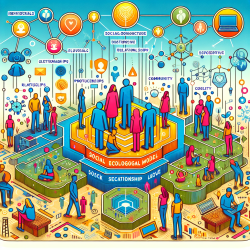Introduction
Adolescent dating violence (ADV) is a pressing issue affecting millions globally, characterized by psychological, emotional, physical, or sexual aggression in adolescent relationships. The mental health repercussions are significant, necessitating effective prevention strategies. A recent systematic scoping review, "Exploring risk and protective factors for adolescent dating violence across the social-ecological model," provides insights into these strategies, emphasizing the need for comprehensive approaches that incorporate risk and protective factors across various social-ecological levels.
Understanding the Social-Ecological Model
The social-ecological model, rooted in Brofenbrenner’s ecological systems theory, highlights the interaction between individuals and their environments, suggesting that ADV prevention must address multiple domains: individual, relationship, community, and societal levels. This model underscores the importance of understanding how these interactions shape ADV risk and integrating this knowledge into prevention activities.
Key Findings from the Review
The review identified a disproportionate focus on risk factors at the individual and relationship levels, with limited exploration of community and societal factors. Notably, there was a significant gap in identifying protective factors, which are crucial for developing strengths-based prevention programs.
- Individual Level: Common risk factors include substance use, mental health issues, and attitudes justifying violence. Protective factors were less emphasized but included cognitive dissonance and higher empathy.
- Relationship Level: Risk factors involve peer influences and family violence exposure. Protective factors include positive family relationships and prosocial peer networks.
- Community and Societal Levels: These levels were under-researched, indicating a need for more studies to identify structural risk and protective factors.
Implications for Practitioners
Practitioners are encouraged to adopt a holistic approach to ADV prevention, integrating strategies across all levels of the social-ecological model. This involves not only addressing individual attitudes and behaviors but also engaging families, schools, and communities in creating supportive environments. Practitioners should also advocate for policies that address societal norms supporting violence.
Furthermore, there is a call for more research into protective factors and structural influences, moving beyond individual-focused paradigms. Practitioners can contribute by documenting successful interventions and sharing insights on effective community and societal strategies.
Conclusion
The systematic scoping review highlights critical gaps in ADV research, particularly at the community and societal levels. By focusing on comprehensive, multi-level prevention strategies and emphasizing protective factors, practitioners can enhance their impact on reducing ADV. For those interested in delving deeper into the research, the original paper can be accessed here: Exploring risk and protective factors for adolescent dating violence across the social-ecological model: A systematic scoping review of reviews.










